Science K to 8
|
Content:
|
Kindergarten
Adaptations of local plants and animals
- Natural History of BC
- Search for name of any local plant or animal, eg:

Forest in the Caren range, Sunshine Coast. Dean van't Schip photo
Local First Peoples’ uses of plants and animals
Grade 1
Experience and interpret the local environment
Recognize First Peoples’ stories (including oral and written narratives), songs, and art, as ways to share knowledge
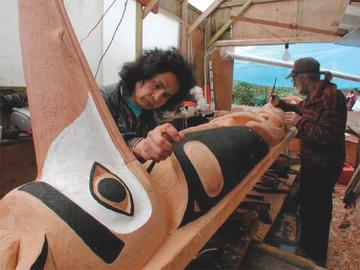
Totem poles are still being made by Aboriginal carvers. They are a familiar sight in British Columbia. Jacqueline Windh photo
Describe activities of Aboriginal Peoples in BC in each Seasonal Cycle
- Give several examples that show how activities of Aboriginal peoples differ according to seasonal cycles and regions (e.g., differences between activities in the Interior/coast; north/south)
- Prepare a detailed list of local Aboriginal activities in the
- Fall (e.g., berry picking, freezing, and drying; equipment readied for hunting season; firewood stacked)
- Winter (e.g., sports activities, feasts, Potlatch)
- Spring (e.g., planting)
- Summer (e.g., picnics, baking bannock, preparing fishing nets)
Grade 2
Recognize First Peoples’ stories (including oral and written narratives), songs, and art, as ways to share knowledge
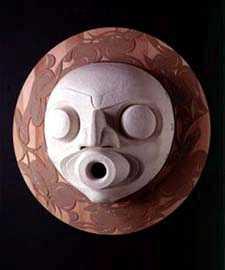
Speaking Great Silence by Susan Point. Kenji Nagai/Spirit Wrestler Gallery
Life Science: Animal Growth and Changes
- Describe how animals are important in the lives of Aboriginal peoples in BC (e.g., marine animals)
- Identify from historical sources how animals were part of the lives of Aboriginal peoples (e.g., bear: fur for warmth during the winter; grease for cooking and personal care; bones for tools)
- Illustrate in detail how animals help to meet the needs of local Aboriginal peoples (e.g., seal oil and meat on the West Coast; eagle feathers in ceremonies)
- There are many complex living organisms in the waters of BC. Do you recognize any?
- Marine Life of the Pacific Northwest, A Photographic Encyclopedia of Invertebrates, Seaweeds and Selected Fishes
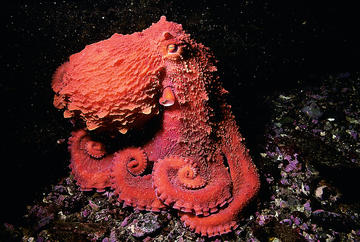
Bellevue Point, San Juan Island, n. Washington
Grade 3
Biodiversity in the local environment
- Biodiversity
- Marine Life of the Pacific Northwest, A Photographic Encyclopedia of Invertebrates, Seaweeds and Selected Fishes
Major Local Landforms
- Search for a landform, eg.:

Moraine Lake framed by the Rocky Mountains.
Courtesy Reimut Lieder/Image Makers
Life Science: Plant Growth and Changes
- Describe how plants are harvested and used throughout the seasons
- Research and report on how BC Aboriginal peoples use plants for food, medicine, and products
- Find examples of how different plants (e.g., trees, berries, grains, herbs, sea plants) are harvested (e.g., logged, picked, by combine) at various times of the year
Grade 4
Life Science: Habitats and Communities
- Demonstrate awareness of the Aboriginal concept of respect for the environment
- Describe in detail how to show respect for the environment
- Create accurate, detailed drawings to illustrate stories that demonstrate the relationship Aboriginal peoples have with the land, water, animals, plants, and sky (e.g. respect for water, earth)
The Tidal Cycle
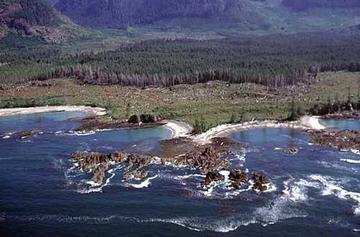
Shoreline of Clayoquot Sound. Adrian Dorst/WCWC
Grade 5
Local types of Earth materials
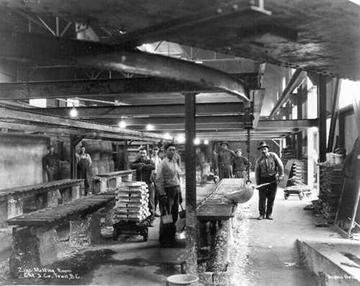
Zinc melting room at the Cominco smelter, Trail, 1930s. Trail City Archives
Physical Science: Forces and Simple Machines
- Describe applications of simple and compound machines used in daily life in BC communities
- Give several examples of some common heavy machines that contain simple machines (e.g., fork-lift, grader, crane, log-loader)
- Illustrate in detail how a combination of simple machines can be used to solve various problems in daily life
- Describe the various ways in which Aboriginal peoples in BC have used machines to meet basic and artistic needs in their daily lives
Renewable and Non-Renewable Resources
- Analyse how BC’s living and non-living resources are used
- Identify methods of extracting or harvesting and processing BC’s resources (e.g., fish: different methods of commercial fishing)
- Illustrate several examples of resource harvesting or extraction (e.g., salmon, trees, oil and gas, water, copper, coal)
- Trace a finished BC resource-based product (e.g., a tin of salmon, cedar basket, oil and gas) to its source
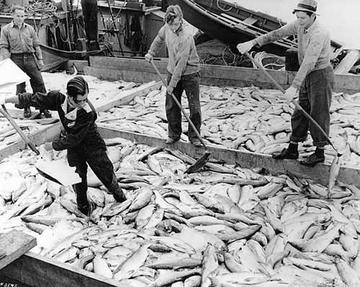
Scow full of salmon being iced down prior to canning, Imperial Cannery dock, Steveston, 1942. City of Richmond Archives
- Analyse how the Aboriginal concept of interconnectedness of the environment is reflected in responsibility for and caretaking of resources
- Illustrate in detail various ways in which Aboriginal peoples take care of the land and the resources
- Explain, citing examples, how and why Aboriginal peoples’ unique relationship with the environment demonstrates responsibility for the land and resources
- Describe potential environmental impacts of using BC’s living and non-living resources
Grade 6
Physical Science: Electricity
- Research how hydroelectric dams work
- Search for a specific nearby dams, eg. Mica Dam
- BC Hydro and Power
- Invite BC Hydro to make a presentation of power lines and transformer, or visit a BC Hydro facility in your community
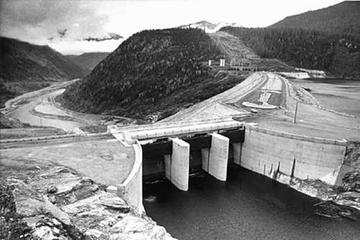
Spillway gates at the Mica Dam, 1977. John Denniston/Vancouver Province
Grade 7
Life Science: Ecosystems
- Evaluate human impacts on local ecosystems
- Describe, using examples, how forestry practices affect ecosystems (e.g., riparian zones, fishing, forest debris, beetle kill, controlled burn)
- Determine the sources of pollutants, and analyse their effects (e.g., autos and air quality, oil spills and water contamination)
- Describe, using examples, how practices of Aboriginal peoples in BC affect environmental sustainability in a specific ecosystem
- Research Aboriginal practices within a specific ecosystem (e.g., river: salmon fishing; intertidal waters: herring roe; forestry: trapping)
- Working in groups, have students identify the pros and cons of Aboriginal practices within a specific ecosystem (e.g., controlled burns, fish wheels, culturally modified trees)
- Discuss the Aboriginal value (concept) of “giving back to the environment what you take” and how it may affect a specific ecosystem (i.e., reforestation, protecting stream beds, harvest rotation)
Earth’s Crust
- Some fossil locations are extraordinary in their preservation. These fossil sites are called fossil Lagerstatten (translates loosely to “motherlode”). The Burgess Shale in BC is one of these and has been designated as a UNESCO world heritage site.
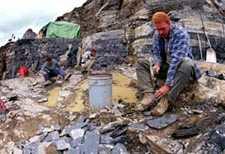
Palaeontology students at work in the Burgess Shale fossil bed, Yoho National Park. Nick Procaylo/Vancouver Province
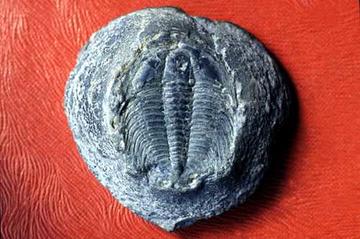
Upper Cambrian trilobite Labiostria, 3 cm long, found in the Fraser Canyon. Rolf Ludvigsen photo
Grade 8
Ways of sensing
- Plate tectonic movement
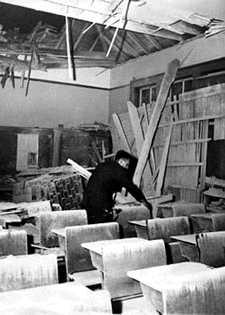
Aftermath of the earthquake of 1946, near Courtenay.
- Major geological events of local significance
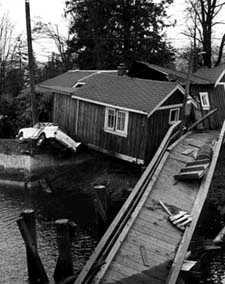
Damage caused by tsunami in Port Alberni, 1964. The wave was generated by an earthquake in Alaska. Deni Eagland/Vancouver Sun
